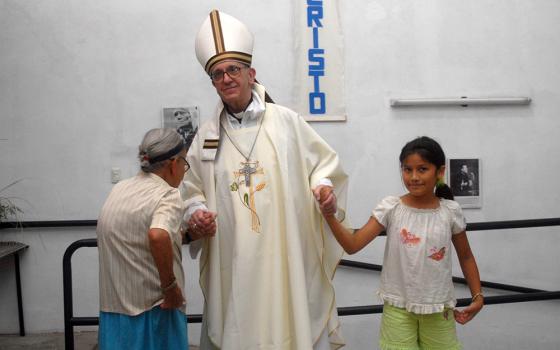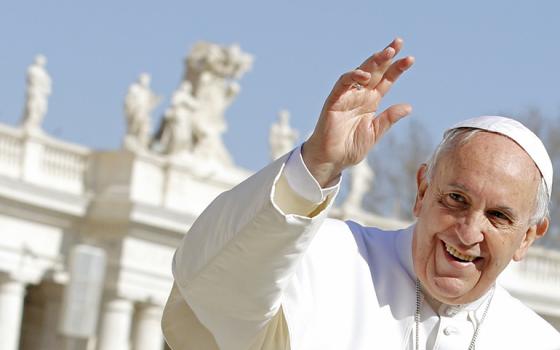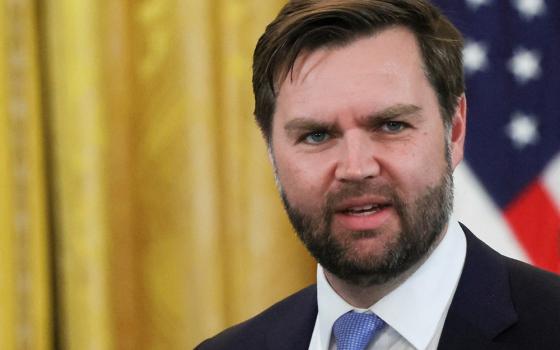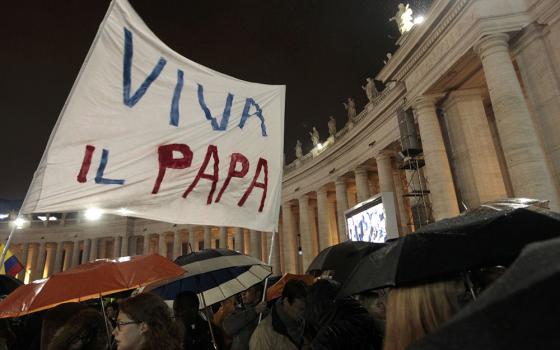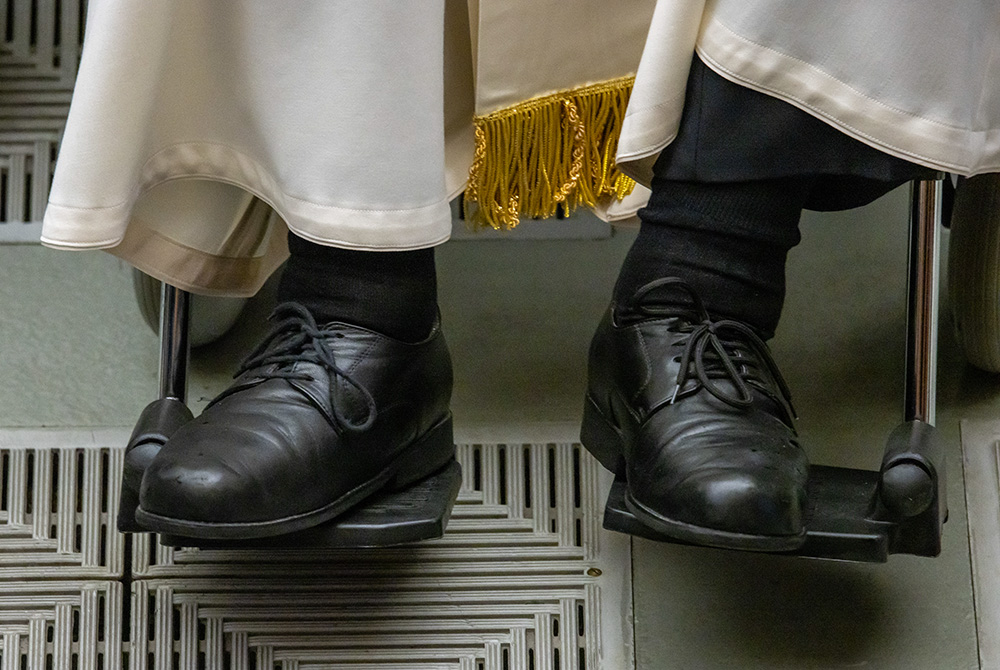
Pope Francis' shoes are seen in a photo as he greets visitors during his weekly general audience in the Paul VI Audience Hall at the Vatican May 1, 2024. (CNS/Pablo Esparza)
The Italians have a saying: "When this pope dies, we shall make another." This should not be understood as flippancy. It is a profound recognition that the church relies on grace to endure and spread the Gospel message, not on the gifts of any particular pope, even a very gifted pope like the one who was laid to rest Saturday.
Now, the cardinals must make that saying their own. They must "make another" pope.
We have all seen the lists of favorites, the papabili. Some are better than others and they all capture the fact that the 135 cardinal electors are choosing a person, not a platform.
The late Cardinal Francis George of Chicago, who participated in both the 2005 and 2013 conclaves, once explained the dynamic to me, how he looked at the different candidates and imagined them sitting in the center chair where the pope sits.
George noted that in 2005, this was relatively easy because Cardinal Joseph Ratzinger led the general congregations at which the cardinals discussed the needs of the church. He also preached and presided at the funeral of Pope John Paul II and at Mass for the Election of the Roman Pontiff immediately before the conclave started. In short, he was already in the presider's chair and filling the role, so it was easy to picture him doing that in a differently colored cassock.
The lists of favorites, however, do not reflect — and cannot reflect — which cardinal will give a speech in the general congregations that puts his finger on the pulse of the church and resonates with his brother cardinals in a way the other speeches do not. Or if there will be several such speeches. In a conclave like this one, in which there is no obvious frontrunner, those speeches will be critical.
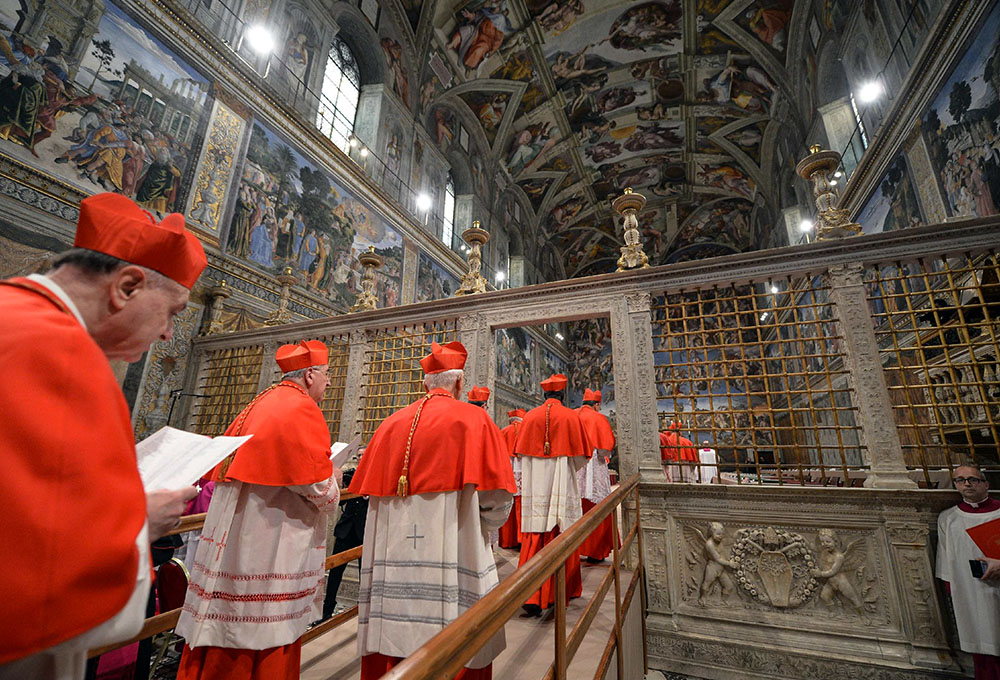
Cardinals from around the world enter the Vatican's Sistine Chapel March 12, 2013, as they begin the conclave to elect a successor to Pope Benedict XVI. (CNS/L'Osservatore Romano via Reuters)
We know from Gerard O'Connell's invaluable account of the 2013 conclave, The Election of Pope Francis: An Inside Account of the Conclave that Changed History, that while Cardinal Jorge Bergoglio was one of a dozen names being floated, and rarely at the top of the list, it was his intervention during the general congregation that catapulted him into the top tier. He spoke about the passage in the Book of Revelation when Jesus stands at the door and knocks.
"Obviously, the text refers to his knocking at the door from the outside to enter — but I think about the times in which Jesus knocks from within so that we let him out," the Argentine cardinal said. "The self-referential church seeks to keep Jesus Christ within herself and does not let him out." By the time he sat down, he was on his way to being elected.
The cardinals knew some other things about Bergoglio in 2013. They knew he was a Jesuit and possessed the sharp intellect for which the order is known. Many of the cardinals knew the central role he had played in drafting the Aparecida document in Brazil in 2007 during the meeting of the Council of Latin American and Caribbean Bishops. The cardinals knew his reputation for simplicity, and for ministry in the favelas of Buenos Aires. He was a remarkable personality.
The cardinals also knew that Bergoglio had been formed by, and helped to form, the reception of the 1962-65 Second Vatican Council in Latin America. That reception was characterized by a deeper degree of episcopal collegiality than anywhere else. It was theologically fecund, more than anywhere else, and the rough edges of 1970s liberation theology had been smoothed down by 2013. The Latin American church applied the teachings of the council to the situation of the church in the Global South. Most of all, it produced pastors.
Advertisement
The 18 Latin American cardinal electors who will enter the Sistine Chapel next week were also formed by that same reception of the council. While no Latino cardinal appeared on any of the lists of papabile, if they rally around one of their own, he will become a formidable candidate.
Those cardinals who want a strong reversal from the reforming direction sketched by Pope Francis will be a tiny minority within the conclave. I count about 15 cardinals, maybe as many as 20, who view the past 12 years as a disaster. Perhaps another 10 cardinals think there needs to be a course correction, and would lean toward a rejectionist candidate set against someone committed to continuing or even accelerating Francis' reforms. Combined, that is not even enough to block someone.
If the anti-Francis cardinals were hoping for help from the "old guard" at the Vatican — men who had served under Pope John Paul II and Pope Benedict XVI — they realized at the funeral on Saturday that such hopes were fraudulent.
Cardinal Giovanni Battista Re, who served as the powerful prefect of the Congregation for Bishops under both of Francis' predecessors, delivered a homily that celebrated the direction in which Francis has led the church. His full-throated endorsement of Francis' approach to exercising the Petrine ministry demonstrated how widespread support for continuing that approach is throughout the college of cardinals.
The real question is whether the majority of cardinals want someone who is charismatic like Francis, or someone who, while committed to Francis' reforms, is more of a manager. This latter was the model the cardinals followed in 1963. After the death of the charismatic Pope John XXIII, who had launched the Second Vatican Council, they turned to Cardinal Giovanni Battista Montini, who became Pope Paul VI. He landed the conciliar plane John XXIII had gotten airborne.
Those cardinals who want a strong reversal from the reforming direction sketched by Pope Francis will be a tiny minority within the conclave.
The problem now is that there is no obvious Montini among the current college of cardinals, someone who knows the Curia inside and out, and who could govern through it to achieve a more pastorally focused Catholic Church. He was the last of his kind. That said, there are some cardinals who have demonstrated effective management of big problems, even if nothing really prepares a man for becoming pope.
The alternative to the manager is someone who possesses some of Francis' charisma, and who wants to double down on the reforms, perhaps even go further than Francis did in reforming the church's structures.
This is about ecclesiology, not moral theology. There will be little appetite among the majority of the cardinals for anyone who is too far ahead of the church on issues related to gay Catholics or the role of women in the church. Francis was a bit ahead of the synod on gay issues and a bit behind on women's issues, so there will be some recalibration perhaps. But anyone who thinks a new pope is going to change doctrine misunderstands what popes do and don't do.
That is the big picture of the conclave at this moment: The cardinals will want to find someone committed to Francis' vision of a church that is more welcoming and less censorious, someone who recognizes the import of pastoral theology, someone who is deeply committed to the poor and the marginalized, someone who grasps the value of synodality to decision-making in the church.
In short, they want to place the "shoes of the fisherman" on someone who can fill Pope Francis' very large shoes. It is a tall order.

